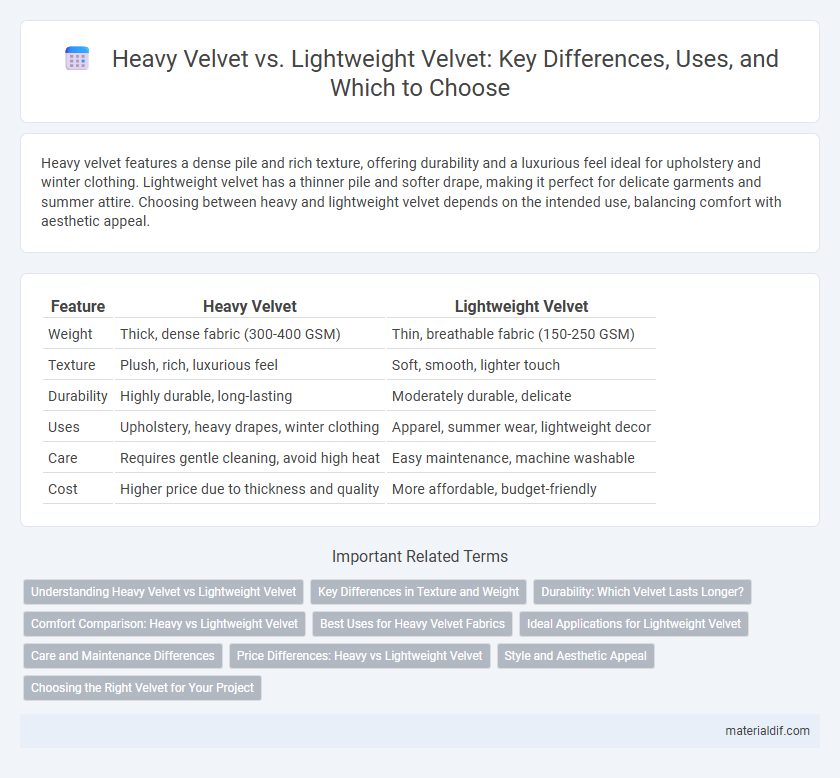Heavy velvet features a dense pile and rich texture, offering durability and a luxurious feel ideal for upholstery and winter clothing. Lightweight velvet has a thinner pile and softer drape, making it perfect for delicate garments and summer attire. Choosing between heavy and lightweight velvet depends on the intended use, balancing comfort with aesthetic appeal.
Table of Comparison
| Feature | Heavy Velvet | Lightweight Velvet |
|---|---|---|
| Weight | Thick, dense fabric (300-400 GSM) | Thin, breathable fabric (150-250 GSM) |
| Texture | Plush, rich, luxurious feel | Soft, smooth, lighter touch |
| Durability | Highly durable, long-lasting | Moderately durable, delicate |
| Uses | Upholstery, heavy drapes, winter clothing | Apparel, summer wear, lightweight decor |
| Care | Requires gentle cleaning, avoid high heat | Easy maintenance, machine washable |
| Cost | Higher price due to thickness and quality | More affordable, budget-friendly |
Understanding Heavy Velvet vs Lightweight Velvet
Heavy velvet features a dense pile and substantial weight, making it ideal for upholstery, drapery, and winter clothing requiring durability and warmth. Lightweight velvet, with a finer pile and lower weight, suits garments like blouses and dresses, offering a soft, breathable texture and elegant drape. Understanding the fiber content, pile height, and fabric weight is crucial for selecting the appropriate velvet type for specific applications.
Key Differences in Texture and Weight
Heavy velvet features a dense, plush pile that gives it a rich, luxurious texture ideal for upholstery and drapery, whereas lightweight velvet has a finer, smoother pile suitable for apparel and delicate accessories. The increased weight of heavy velvet contributes to its durability and warm feel, while lightweight velvet offers greater breathability and fluidity. These textural and weight differences influence both the functional uses and aesthetic appeal of each velvet type.
Durability: Which Velvet Lasts Longer?
Heavy velvet features densely woven fibers that enhance its durability, making it resistant to wear and tear over time. Lightweight velvet, while softer and more flexible, tends to show signs of abrasion and pilling sooner due to its thinner pile. For upholstery or high-traffic applications, heavy velvet typically offers longer-lasting performance and maintains its luxurious appearance longer than lightweight velvet.
Comfort Comparison: Heavy vs Lightweight Velvet
Heavy velvet offers a dense, plush texture that provides substantial warmth and coziness, making it ideal for colder climates and winter apparel. Lightweight velvet, while still soft and luxurious, allows for better breathability and flexibility, enhancing comfort in milder weather or layered outfits. Choosing between heavy and lightweight velvet depends on the desired balance of insulation and ease of movement for the intended use.
Best Uses for Heavy Velvet Fabrics
Heavy velvet fabrics offer durability and a luxurious texture ideal for upholstery, drapery, and winter garments. Their dense pile provides excellent insulation and resistance to wear, making them perfect for high-traffic areas and cold weather clothing. Rich in opulence and structure, heavy velvet lends itself well to statement pieces like sofas, curtains, and tailored coats.
Ideal Applications for Lightweight Velvet
Lightweight velvet is ideal for apparel such as blouses, dresses, and scarves, offering luxurious texture without the bulk of heavier fabrics. Its breathable and flexible nature makes it perfect for spring and summer collections, enhancing comfort and style. Lightweight velvet also suits home decor accents like curtains and pillow covers, where a soft touch is desired without overwhelming the space.
Care and Maintenance Differences
Heavy velvet requires gentle cleaning methods, such as dry cleaning or spot cleaning with mild detergent, to maintain its dense pile and prevent crushing. Lightweight velvet can often be machine washed on a delicate cycle, but still benefits from air drying to preserve its texture and avoid shrinkage. Both types should be stored away from direct sunlight and moisture to prevent fading and mildew buildup.
Price Differences: Heavy vs Lightweight Velvet
Heavy velvet typically commands a higher price than lightweight velvet due to its dense weave and increased material usage, which enhances durability and luxury appeal. Lightweight velvet, being less dense and thinner, is more affordable and suitable for projects requiring softer drape and reduced weight. The price gap reflects differences in production costs, fabric weight, and intended applications in apparel or upholstery.
Style and Aesthetic Appeal
Heavy velvet offers a rich, opulent texture ideal for luxurious drapery and upholstery, creating a dramatic, sophisticated ambiance. Lightweight velvet provides a softer, more fluid drape suited for fashion garments and casual upholstery, delivering a modern, elegant look with enhanced comfort. Both types enhance style with their distinct tactile qualities and varying levels of sheen, catering to diverse aesthetic preferences.
Choosing the Right Velvet for Your Project
Heavy velvet offers a luxurious, dense texture ideal for upholstery and drapery projects requiring durability and rich depth. Lightweight velvet provides a softer, more flexible feel suited for apparel and delicate home decor, ensuring comfort and ease of movement. Selecting the right velvet depends on balancing the project's functional needs with aesthetic goals, emphasizing fabric weight and pile density.
Heavy Velvet vs Lightweight Velvet Infographic

 materialdif.com
materialdif.com